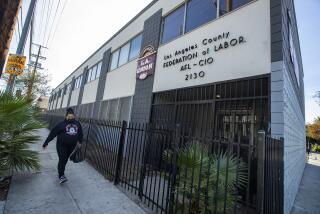The News Media Was Right to Ignore Plea by Mayor
- Share via
Mayor Maureen O’Connor showed up Thursday at a press conference called to announce the San Diego Police Department’s suspicion that one of its own was guilty of a brutal attack. She did so, she said, to express her faith in the department and to make an extremely unusual request.
Calling on her long relationship with local reporters, the mayor implored the media not to use the names of the victims. She said the families had requested that she ask reporters to respect their privacy.
The reaction was predictable. The media ignored the mayor’s request. The names of the two assault victims already were common knowledge, a third victim’s name had not been released at the time of the press conference. Every major news operation followed standard procedure and printed the names.
Either the mayor was grandstanding (a shocking thought), or she was displaying an alarming lack of understanding of the operation of a free press.
News is about giving people information, not withholding it. When a rape is involved, the society-imposed stigma of the crime traditionally has restrained media from using the name of the victim. Only the highly sensational William Kennedy Smith case has blurred that line, which still remains absolute in the minds of most editors.
In most cases, though, the public has a right to know who was involved in crimes, even the victims. The mayor’s request seems to appeal to the notion that the public should not be told the name of someone who has been murdered or assaulted, simply because the case has been well-publicized case and happens to involve a cop.
When necessary, the press can be more sensitive than people think. The Police Department asked the media not to show pictures of the suspect, Henry Hubbard, Jr., and most media organizations honored that request, even though to do so was actually a moot point, since the San Diego Tribune ran his picture Thursday afternoon (and also used the names of the victims). To honor such a request is not unusual when a suspect may have to be identified in line-ups.
KFMB-TV (Channel 8), in particular, went to extreme lengths to honor the department’s request. In an extraordinary twist, four years ago Channel 8 had done a feature on the San Diego Police Academy, which featured Hubbard, and they had several interviews with him as a result. Thursday night, as the story was breaking, they showed excerpts from the tape, but blocked out his face throughout. Friday night Channel 8 was still acquiescing to the Police Department, blocking out his face, even though his photo had appeared in the papers and other television stations were showing it.
But it is an entirely different issue to intentionally conceal the identities of the key players in a horrible scene.
The people “didn’t ask to be victims,” the mayor said.
That’s true. But fate, not the media, has thrust them into that role. It’s the job of news organizations to give the public the facts, and let them see as much of the big picture as possible. In most cases, the overriding factor must be the public’s right to have all available information. It’s not the role of the media to go out of their way to show prior restraint, to censor themselves.
These people shouldn’t be given special treatment, simply because it is a high-profile case and the mayor decided to get in front of the television cameras.
After two years and $600,000 in expenditures, Channel 17 still isn’t ready to go on the air. A week ago, the operators of the low power television station finally tested their transmitter for the first time, only to discover that it interfered with the signal of a Los Angeles-based Spanish-language station KSCI being transmitted to Cox Cable.
Station manager Glenn Shoemaker said he expected to have the engineering problems solved by today, and that the station would begin to transmit a station logo as soon as possible. The station could be fully operational by October, he said, which sounds vaguely familiar.
Low power television stations are fully functional television operations with very limited signals. Efforts to get low power stations on the air in San Diego have been hampered by slow negotiations with the Mexican government over signal conflicts and various other technical problems. Spanish-language KBNT-TV (Channel 19) is the only low power station currently operating in San Diego.
The license for Channel 17 is controlled by former City Councilman and perennial candidate Floyd Morrow and his Basic Economic Education Foundation. Its signal, beamed from a transmitter in Poway, will reach homes in an approximately 20-mile radius. When it finally gets on the air, the station hopes to offer a wide range of ethnic and community-oriented programs.
As for the other low-power stations in San Diego, Channel 63, which is controlled by John Willkie operating as Civic Light Inc., is currently raising capital through a private stock offering. They hope to be on the air within a year, using a transmitter located downtown.
The concept of cheesy takes on a whole new dimension when it involves a television anchorman singing country music. Picture Channel 10 anchorman Stephen Clark crooning in an East County bar last week. Picture the extensive Channel 10 coverage. Picture Channel 10 interviewing its own anchorman. This is what cheesy means. . . .
KPBS-TV (Channel 15) is scheduled to air three half-hour episodes of the children’s show “The New Secret City Adventures” this week, featuring voices and an original score by local Mike Keneally. The episodes are scheduled for today, Tuesday and Wednesday at 4 p.m.
More to Read
Sign up for Essential California
The most important California stories and recommendations in your inbox every morning.
You may occasionally receive promotional content from the Los Angeles Times.













